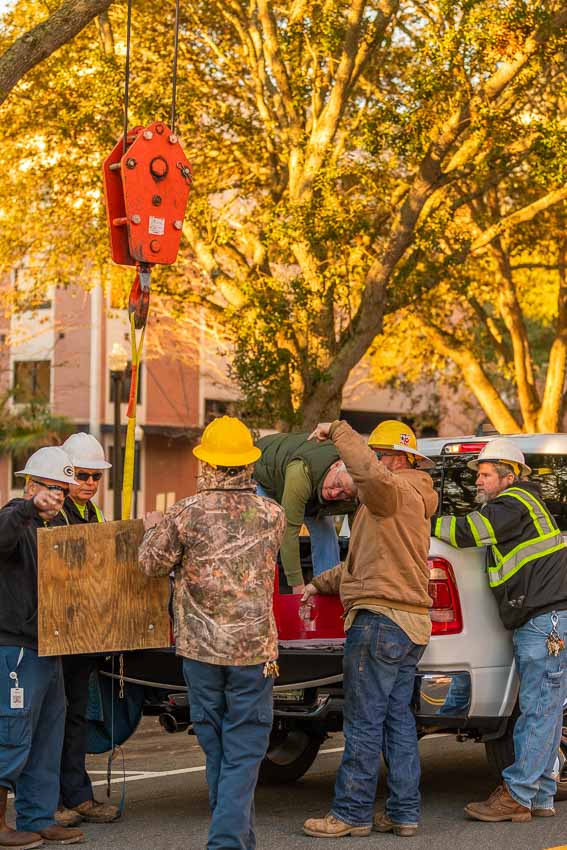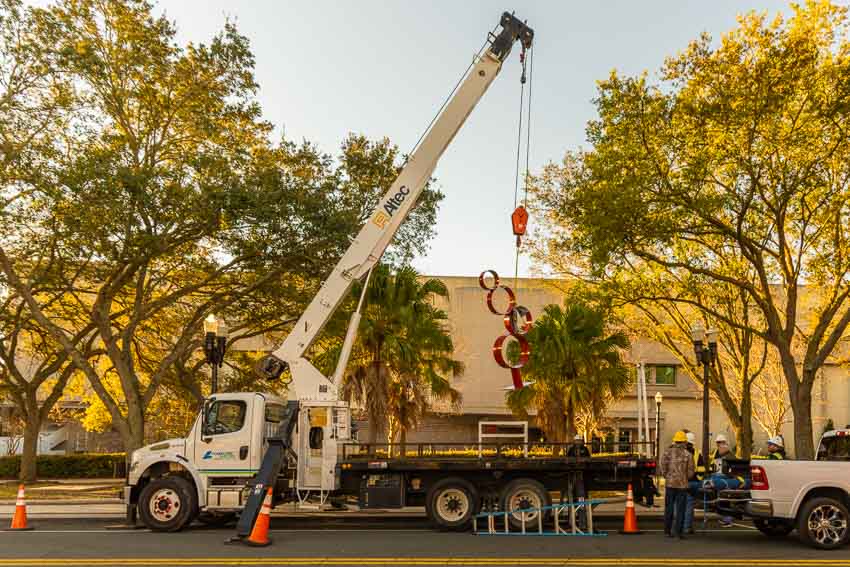If you work on a construction site long enough, chances are you are going to have to learn how to work safely around cranes. Cranes set rafters. They install HVAC units on roofs. Cranes even assemble steel beams. In our case, however, we use cranes to install very heavy sculptures. Consequently, crane safety and using cranes safely is a very big deal.
While working for the Polk Museum of Art, twenty-two years ago I helped create the Florida Outdoor Sculpture Competition with the City of Lakeland. Our local power company, Lakeland Electric, helps us use their cranes safely to install some of our heavier sculptures each year.
Table of Contents
Mind the Load
On a construction site, you will find more than just cranes. Telescopic forklifts known as telehandlers are a combination forklift and crane. Telehandlers lift heavy loads on pallets to second, third, or fourth-floor heights. To install a new roof, we used a telehandler recently at the Polk Museum of Art.
When raising the load, never let anyone get near the load. This is the single most important rule when using a telehandler.

You should also never use them to raise a person. Manlifts (high-maintenance platforms) are for lifting people and provide safety mechanisms for this purpose. In general, all safety rules for cranes apply to telehandlers and manlifts.

Crane Safety 101 – Wear Proper Safety Equipment
When it comes to working around cranes, wear a hard hat! No piece of safety equipment or PPE is more important than a hard hat. In fact, another name for the hook on a crane is a “headache”. Guys often say “headache coming your way” to let you know the hook is coming toward you.


Second to the hard hat is a high-visibility safety vest or clothing. These make sure the crane operator (and your fellow workers) can see you. This is extremely important when he or she is guiding several tons of materials in your direction.


Steel-toe boots are important in case a load slips and lands on your foot. Companies often require steel-toe shoes. When working around a crane individuals can be disciplined, fined, or even fired for not wearing steel-toe shoes.
Finally, traffic cones are a must. Crane operators keep them on the crane for placement around their outriggers. However, you will often need to put them out even before the crane arrives on-site. This serves to reserve a parking location for the crane. You may need to close traffic lanes when the crane is in operation.

Crane Safety – Traffic Control
Traffic control is a big part of crane safety. You are not just trying to keep workers safe but also the general public and any onlookers. Traffic control doesn’t start when the crane shows up on site. It usually starts a few days before at a minimum. Plan where the crane is going to be placed. Plan where the crane is actually able to lift from (we call that a pick point). Take note of any overhead obstructions such as powerlines, etc. You also need to know the weight of the object you are lifting. Once you know all this, then you can determine if you need to reroute traffic or block off parking spaces.
Blocking The Streets
In the Florida Outdoor Sculpture Competition, we have to reserve enough parking spaces for the crane and the artist with their trailer. Then, when we actually do the pick (lifting the sculpture off of the trailer) we need additional personnel or police to help block the city street for about 10 to 20 minutes. It is very tempting for the traffic control personnel to watch the installation of the sculpture because you don’t see that happening every day. It is however much more important that they pay attention to what they are doing. Here, traffic safety equals crane safety!

Crane Safety with Respect to Rigging
Rigging is the act of attaching the load to a crane. On smaller jobsites, the foreman or construction engineer has this responsibility. Bigger jobs include a dedicated rigger who is responsible for doing this. Doing rigging properly is complex. Each load requires “back of the napkin” math/engineering. When in doubt, go stronger than you need!
Slings will have three weight ratings on them corresponding to the sling configuration. One rating is for a choke, one is for a basket and one is for straight vertical suspension. Each configuration or method of attaching the load changes the maximum weight rating of the sling.

Choker is what most people seem to prefer because it is the most secure, but it is also the weakest. Therefore buy bigger slings that you think you will need. The age and condition of the slings and even the weather change your calculations too. All of this is well beyond the scope of this article. See IPT’s Crane and Rigging Training Manual for more information.


Using Cranes Safely – Area Awareness and Body Position
When working around any sort of heavy machinery, you have to be aware of your surroundings. This applies doubly so when it comes to using cranes safely. You not only have to look all around you, but now you have to look up as well! Effective crane safety begins on the ground—always know where the load is. Never get underneath it.
This includes any time the load is low to the ground. Keep your feet out from underneath the load. In the event we do have to get under a load—like when we need to install bolts to secure it—we always block it up on wood beams like railroad ties or on the edge of the trailer/truck. This ensures the piece cannot physically fall on us.

That First, Most Dangerous Moment
One of the most dangerous times during a pick is when the load first comes up off the ground or trailer. No one is exactly sure how it is going to behave. The load can tip over if it is not balanced. There is nothing scarier than a few tons of weight suddenly out of control. This is the point where someone can get a limb crushed, get a part of their body amputated, or even killed. Using cranes safely means you have to pay attention!
Make sure you are never between the load and another object. An example would be between the load and a vehicle, tree, or building. When the load is low to the ground, I like to keep a hand on it so I can feel any movement it makes while I scout the surroundings for obstacles. If other people are doing the same thing, make sure you are not fighting each other, all pushing in different directions. People experienced around cranes will let the load go where the crane operator is taking it. They are just there to keep it from spinning out of control which can be a disaster.
Tag Line
When the load gets too high to comfortably keep a hand on it to keep it from spinning, that is where a tag line comes in. Tag lines are ropes that you tie to the load to control it. Always keep one handy when using a crane.
Hand Signals or Radio Commands
When arriving on-site, the crane operator needs to figure out who is in charge. He or she needs to identify the foreman, rigger, or whoever is giving commands. They are the only person who should be giving commands to the operator. While only one person can give hand signals, anyone can call an emergency stop.
Obviously, construction sites make lots of noise. This noise makes it difficult, if not impossible, to hear spoken directions. Using cranes safely requires good communication regardless. Often the crane operator cannot see what he or she is doing. It is up to someone else such as a site supervisor, foreman, or rigger to give hand signals to the crane operator. Most sites use hand signals. Commercial sites with tower cranes usually use radios for communications.
Hand Signals Case Study
At the Polk Museum of Art, we have a sculpture garden with a 12-foot solid brick wall all the way around the garden. When we get sculptures delivered, I usually have to get on an extension ladder and climb on top of the wall. From there I can give hand signals to the crane operator who is totally blind to what is going on inside the sculpture garden.
He or she has to completely trust where I am guiding them. They must trust that I will not hit anything or overextend the boom too far for the weight we are lifting, etc.


Crane Safety Basics – Summary
This article covers the basics of crane safety for small to medium size construction sites. To learn more about the commercial/industrial side of cranes and rigging, check out Dale at Rigging & Crane Tips YouTube channel. For the most part, crane safety is common sense. It does require that you pay attention at all times. You cannot slack off or lose your focus. If you do, you could seriously injure yourself or someone else.




